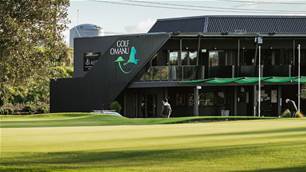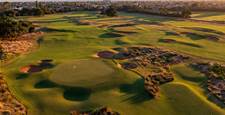Victoria’s High Country and the adjoining Goulburn Valley region are perhaps the least known of the state’s golfing destinations, despite the number of easily accessible and affordable courses on offer.
Historic towns like Shepparton, Euroa, Mansfield, Glenrowan, Myrtleford and Wangaratta are perhaps more infamous as the places where bushrangers like Ned Kelly, Harry Power and Daniel ‘Mad Dog’ Morgan roamed during the gold rush years of the mid to late 1800s.
In the 21st century the picturesque northeast of Victoria is renowned for its world class food and wine, burgeoning art scene and, of course, natural attractions. Golf is not a major tourism drawcard like other Victorian regions but there are some interesting, and challenging, layouts to be found.
Shepparton, about 150km from the northern outskirts of Melbourne, lies on the banks of the Goulburn River and is today considered the heart of the “food bowl of Australia”.
Golf didn’t arrive in the town until the turn of the century, and it wasn’t until 1922 that the Shepparton Golf Club moved to its current site, on the east bank of the Goulburn River, what was then a “two-and-a-half mile” trek out of town. A nine-hole sand scrape course was laid out, and another five holes added in 1926. The course was extended to 18 holes in 1932 after the club purchased 20 acres of adjoining land, and this is where the opening five holes and the par-5 9th hole of the current course now lie.
By the mid-1950s Sam Berriman was a highly regarded golf course architect who was the creative mind behind new designs at Cranbourne, Keysborough and Southern. He had also overseen the construction of Charles Alison’s Huntingdale design. In 1956, the call came from Shepparton to create a new 18-hole grass green layout across its rolling property.

Berriman faced a landscape with far more elevation change than any of his Melbourne creations. It is testament to his fine work that the bones of his design remain more than 60 years after the layout officially opened for play.
One of the standout observations of Berriman’s work here is the quality of the dogleg holes. There’s a good mix of right-to-left and left-to-right holes of varying degrees, which have mostly been created to camber beautifully across the rolling terrain. The short par-4 6th is a fine example where you are faced with a blind tee shot but the key to playing the hole well is hitting into the right side of the fairway to allow for the right-to-left sloping fairway. For the second shot, there is every chance your ball will be lying above your feet and, for right-handers, this brings the back left greenside bunker well into play.
As you walk to the 10th tee, you will pass a grass tree and plaque honouring the late Jarrod Lyle, who sadly lost his battle with leukemia in 2018, aged just 36. The fun-loving married father-of-two learned the game at Shepparton and would become its champion golfer before turning professional and, ultimately, heading to the PGA Tour.
It only takes one round at Shepparton – with its twisting fairways, smallish greens and the need for a devilishly good short game – to realise how Lyle honed his silky-smooth action to become such an accurate ball-striker.

Lying on the western side of the Goulburn River, and about nine kilometres to the south of Lyle’s home course, is the Mooroopna Golf Club, which dates to 1929.
Like Shepparton, it began as a nine-hole sand scrape course and was expanded to 18 holes not long after World War II before being converted to grass in 1966. But the biggest changes to the course have all been modern ones.
Starting in 2003, the club undertook a six-year rebuild of its greens, as well as laying couch on all its fairways. More recently, three new holes – the 12th, 13th and 14th – have been created on the north-eastern edge of the property. The landscape surrounding these new holes is quite sparse, which is in stark contrast to the more established, densely tree-lined remainder of the course.

Two of Mooroopna’s most memorable holes are par-3s. The 166-metre 7th features water in front of the tee and flows into a bigger billabong lining the right side of the hole. Water isn’t the only hazard here with two bunkers nestled in close to the putting surface.
Water and sand are also a factor on the 195-metre 17th hole, which also features an updated green complex. A pond lies left of the hole, but it is the bunkers short and left of the putting surface that will grab the miscued tee shot.
Venture further west for 15 minutes via the Midland Highway to Tatura and the Hill Top Golf & Country Club, which lies on the edge of a 1990s created residential estate where street names like Sunningdale, Birkdale, Seminole and Augusta pay homage to the game.
The course dates back to the mid-1960s and was originally created by Eric Horne, who previously designed several courses across southern Victoria including Portarlington. The subdivision of building lots around the edge of the course secured the future of the club.
The 1990s development, on the northern edge of the course, saw the creation of five new front nine holes – from the par-5 4th to the short par-4 8th – designed by Peter Thomson, Mike Wolveridge and Ross Perrett.

The most challenging of Hill Top’s par-3s is found among this quintet. At 148 metres, the 6th is reachable for all but with a lake in play to the left and two bunkers short and right of the upturned dish putting surface, an accurate tee shot is a must here.
The aforementioned 8th hole has claims as the best of Hill Top’s short par-4s. Standing on the tee, you need to decide if you are brave enough to take an aggressive line down the left half of the dogleg left fairway. This playing line brings a large bunker and lake into play, but if you find the Legends couch fairway safely, you are left with the easier approach shot into the massive double green shared with the 4th hole.
The heritage town of Euroa, about 50km south of Shepparton, lies at the base of the beautiful Strathbogie Ranges. It was here in 1878 that Ned Kelly and his gang went into hiding after robbing the National Bank in Euroa. They emerged a week later and, in an attempted robbery of the Bank of Victoria in Shepparton, an angry female customer wielding an umbrella thwarted the hold up by hitting Kelly repeatedly over the head.
Nearly 30 years after those raids, the Euroa Golf Club was formed and a nine-hole sand scrape course was laid out by Melbourne golf professional Rowley Banks, who would later design the first Woodlands and Portarlington Golf Club layouts.

There have been several moves around town since, but the current Euroa course was set out by acclaimed architect Vern Morcom in 1948 and is identical to his original plan with the exception of the bunkers he envisioned. Bunkers were abandoned by the club after just a few years as the local creek sand was unsuitable and they were changed to grassy hollows.
Euroa today is a pretty course – thick with a wide variety of tree species, although dominated by gums, especially Red and Lemon-Scented – while natural and interesting undulations, affecting shot choices, come into play on several holes.
Related Articles

Review: Omaha Beach Golf Club

Drinks With... Ricky Ponting












